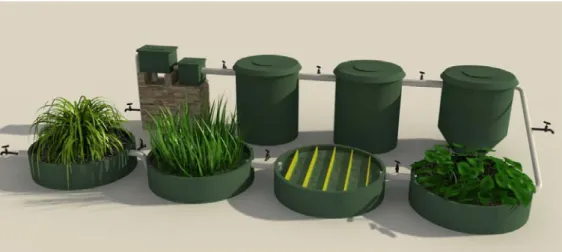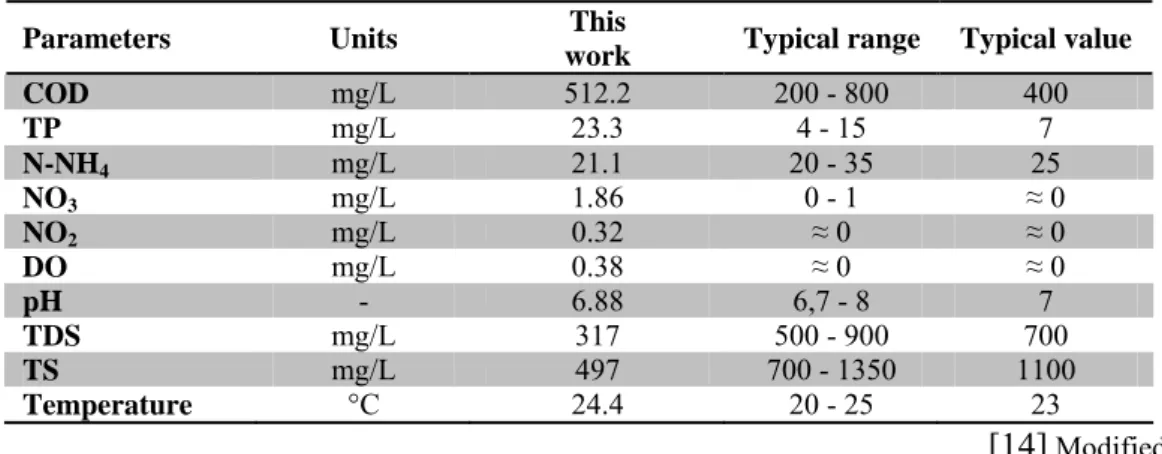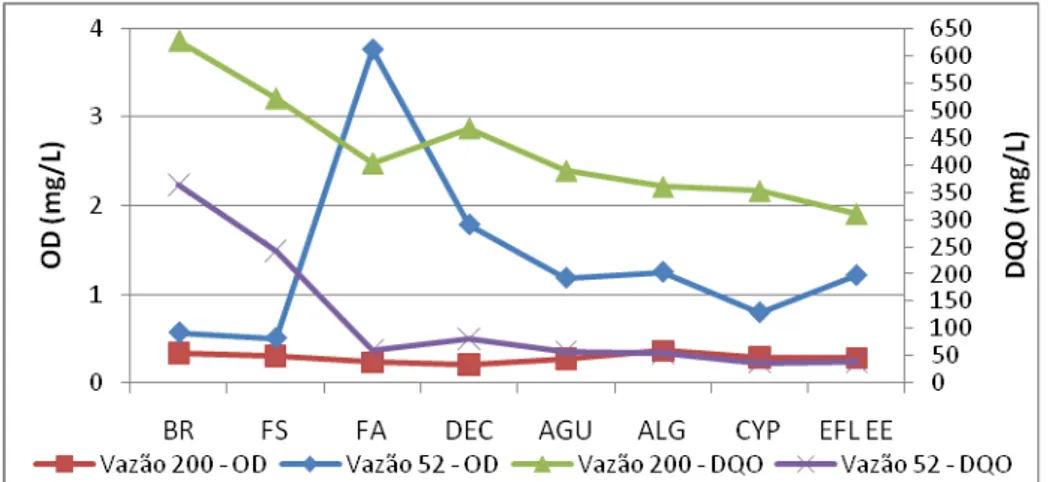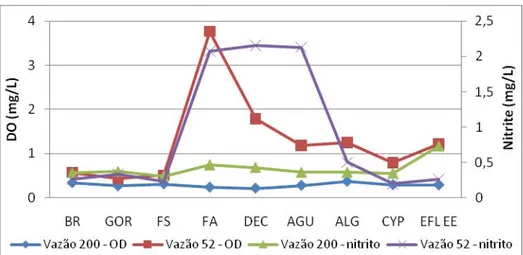ENGINEERED ECOSYSTEM FOR
DECENTRALIZED TREATMENT OF
SEWAGE FROM SMALL GENERATORS
AND ISOLATED COMMUNITIES
André Luis de S. Salomão
1Marcia Marques
1,2Odir C. da C. Roque
11
Rio de Janeiro State University-UERJ, Brazil
2Linnaeus University, Sweden
ABSTRACT
In different regions of the world as well as in many parts of Brazil, high percentage of the population and sometimes, entire isolated communities do not have access to sewerage system or sewage treatment. The common scenario is the use of septic tanks and, in many cases, direct discharge into water bodies. The objective of this study was to develop and test a low-cost sewage treatment system, appropriate for isolated or poor communities at the same time, meeting the discharge threshold limits established by the Brazilian regulation. For that, a compact engineering ecosystem for decentralized treatment of domestic sewage was constructed and tested in a research unit installed in an environmental protected area in Grande Island, south coast of Rio de Janeiro State. The system is formed by septic tank, submersed aerated filter, secondary decanter, and for polishing, vegetated tanks containing aquatic macrophytes (wetland) and one tank with algae. The results of a 200 day monitoring period, covering two different flows rates (200 L.h-1 and 52 L.h-1) are presented. With the lower flow (52 L.h-1), the following removal efficiency was achieved: 87.8% (nitrite); 71% (nitrate); 47% (Ammoniacal nitrogen); 89% (COD); 40.2% (total phosphorus). After the flow reduction, most of parameters analysed, met the threshold limits established by the Brazilian Federal Legislation, which demonstrated that the system fulfilled its purpose.
KEYWORDS
municipality with sewerage system discharge untreated sewage into water bodies. About 51.5% of these municipalities use these water bodies for water supply. In Brazil, wastewater treatment systems include secondary treatment (27.3%), only primary treatment (13.6%) and only preliminary treatment (10%). Only 4.5% of the municipalities have tertiary treatment [1]. Due to the large number of small municipalities, septic tanks are still the most common strategy for treating sewage (45.3%) according to IBGE [1]. One treatment option that has recently increased is the use of constructed wetlands. This type of treatment is currently found in 109 municipalities, already reaching approximately 2% of all Brazilian municipalities. Due to the economic and structural impossibility of constructing centralized sewerage and sewage the investigation about technological options designed to meet the needs of small communities and isolated communities, with compact and decentralized systems has increased [2, 3]. In general, these systems exhibit characteristics such as simple technology, low maintenance and operation costs, low energy demand, high capacity for nutrient removal and the possibility of installing them close to the source [3, 4]. Based on these concepts, the decentralized and compact system of sewage treatment, called Engineered Ecosystems as proposed by Kavanagh & Keller [3] became a good alternative for decentralized treatment of domestic sewage generated by small or isolated communities. Such system includes conventional treatment units, like a septic tank and submersed aerated filter, combined with vegetated tanks, with the purpose of final polishing, combining in this way the three treatment levels (primary, secondary and tertiary) in a single and relatively simple system. The purpose of this investigation was to design, construct and test a decentralized compact sewage treatment system to meet the demands of small/isolated communities, using low cost, easy-to-operate concepts, based on biological and ecological engineering principles that also meet the threshold limits established by the Brazilian’s regulation.
2 MATERIAL AND METHODS
Treatment Plant: The engineered ecosystem (EE) was installed and operated nearby the Centre of Environmental Studies and Sustainable Development-CEADS a research campus of the Rio de Janeiro State University-UERJ, located in Grande Island (23°18’ S, 44°19’ W), Angra dos Reis Municipality, Rio de Janeiro State, Brazil. The CEADS is placed in an environmental protected area, which is part of UNESCO's World Network of Biosphere Reserves since 1992. The campus, with nine administrative employees receives an average of 17 visitors day-1, including students and researchers. A compact system, in real scale, was built (Figure 1), modified from Kavanagh & Keller [3], and it was operated in two different flow rates, 200 L.h-1 during the first 148days (including the initial acclimatization period of two months) and 52 L.h-1 during 52 days. The EE description and dimensioning criteria are shown in Table 1.
Figure 1: Graphical design of the side view of Engineered Ecosystem (EE).
Table 1: Dimensioning and operational parameters for the Engineered Ecosystem units
Treatment Unit (*) Dimensioning parameters Flow rate
Operating parameters Reference
Equalizing tank - - 200 Flow controlling box 0.6 m x 0.4 m x 0.4 m 52 - - 200 HRT = 0 h Grease collector 0.6 m x 0.4 m x 0.23 m 52 HRT = 0 h - 200 HRT = 6.6 h Up-flow septic tank 1.27 m x 1.15 m; 1.32m3 52 HRT = 25.4 h [5, 6]
200 S.O.L. = 0.054 kg DBO m-2 day-1; Carriers
surface area = 200 m2 m-3; A. R. = 53.25 m³
day-1 kg-1 of BOD; HRT = 6 h
Aerated
submerse filter 1.25 m x 1.17 m; 1.35m3
52 S.O.L. = 0.014 kg DBO m-² day-1; Carriers
surface area = 200 m2 m-3; A. R. = 53.25 m³
day-1 kg-1 of BOD. HRT = 23.1 h
[6] 200 Runoff rate: 4.6 m³ m-² day-1; HRT = 4.8 h
Secondary
decanter 1.15 m x 1.15 m 0.96m3
52 Runoff rate: 1.2 m³/m².d; HRT = 18.5 h
-
200 Runoff rate: 2.2 m³ m-².day; Max. load rate:
1154 kg BOD ha-1 day-1; HRT = 3.4 h
Surface flow –
wetland 0.33 m x 1.62 m 0.68m3
52 Runoff rate: 0.6 m³/m².d; Max. load rate: 300 kg BOD ha-1 day-1; HRT = 13,1 h
[7] 200 Runoff rate: 2.2 m3 m-2 day-1; Max. load rate:
605.8 kg DBO/ha day-1; HRT = 2.8 h
Algae tank 0.27 m x 1.62 m 0.55m3
52 Runoff rate: 0.6 m3 m-2.day-1; Max. load
rate:157.5 kg DBO ha-1 day-1 HRT = 10.7 h
[7] 200 Runoff rate: 2.2 m3 m-2 day-1; Substrate depth:
0.25 m; B.R.A.: 0.04 Kg BOD m² day-1; HRT =
Vertical
sub-superficial 0.27 m x 1.62 m 0.55m3
Some of the units in the system were scaled by a factory that produces glass-fibers tanks. The system constructed in the Island for testing and demonstration was dimensioned to treat a volume equivalent to 1.38 kg DBO day-1 and 4800 L day-1, in 200 L. h-1 flow rate (equivalent to approximately 8 households with 4 persons or 60 persons per day in a hosting house). After 148 days of monitoring with a frequency of 2 times a month, the flow was reduced to reach the treatment of 0.36 kg DBO day-1 and 1248 L day-1, with 52 L.h-1 of flow (approximately 2 households with 4 persons or 15.6 persons per day in a hosting house). The up-flow septic tank performs the primary treatment by reducing the sedimentation and increasing the contact time between the organic load and microorganisms, increasing the treatment’s efficiency. In this unit, highly molecular weight non-biodegradable matter is hydrolyzed to smaller compounds [8]. The continuous submerse up-flow aerated filter (see details in Table 1) was filled with 80 cm (h) and 0.94 m2 of PVC carriers. A circular PVC aeration hose placed in the bottom of the tank supplied the system with atmospheric air in such manner that oxygen diffusion was favoured, being more concentrated in the bottom where higher demand for oxygen takes place [9]. The dissolved oxygen (DO) was kept as much as possible within the range of 2-3 mg O2 L-1 [2]. Nevertheless, it should be pointed out that in such completely mixing tank, the
concentration of organic matter is in principle, similar in any point the tank [9].
With the aim of removing the nutrients and the remaining organic load, in a polishing stage, the tertiary treatment included three vegetated tanks or wetland systems and one algae tank. Aquatic macrophytes were collected in the surroundings in the Island, where the final effluent is discharged. They were chosen according to the role to be played in the treatment system.
Eichhornia crassipes (water hyacinth) was used in a floating macrophytes tank with surface flow. This specie was selected due to its well-known tolerance to eutrophic environments and highly polluted waters [10]. Additionally, this specie promotes efficient filtration of solid particles and microbiota fixation (periphytons) in the roots [10]. Algae were chosen due to metabolic properties that make them highly effective in uptaking nitrogen and phosphorus [11] and fast growth. For the sub-surface vertical up-flow tank, a Cyperaceae (Schoenoplectus sp.), which is an emergent macrophyte was chosen due to its adaptation to constant flooding and fast growth. For the horizontal sub-surface flow tank, a macrophyte with capillary roots and fast growth was chosen, the Gramineae Panicum cf. racemosum, from the family Poaceae. This particular grass was collected from the exact place where the effluent is discharged. Macrophytes seedlings were planted in a stone bed (with average granulometry between 9.5 and 19 mm) randomically, when the system was still filled up with tap water. Due to possible phyto-toxic effects from the high polluted load, the sewage was applied gradually [4], during 3 weeks [12].
Sampling and analytical procedures: The effluent of each tank was monitored every two weeks, under two types of flow (200 L.h-1and 52 L.h-1), from April to October/2009. Sampling was carried out in the morning, from ten sampling points, including the affluent (a), the final effluent (e) and seven outlet points after the units described in Table 1. Physical and chemical variables were analysed according to APHA [13] with the following APHA-methods: pH (4500 H+B); dissolved oxygen-D.O. (4500-O G); chemical oxygen demand-COD (5220 D); temperature (2550); nitrite-NO2-(4500-NO2- D); nitrate-NO3- (4500-NO3);
N-Ammoniacal N-NH4+ (4500-NH3 D) and; total dissolved solids-TDS (2540). Total
3 RESULTS AND DISCUSSION
The previous characterization, quantitative and qualitative, of the affluent of sewage treatment system is fundamental and necessary for the correct sizing and may help explain how the system works, as well as the removal rates and the efficiency of each unit. Table 2 shows the average values found in the EE affluent and typical values of the Brazilian sewage, founds in literature.
Table 2: Quality parameters of the raw sewage that enter the studied EE compared to values in the literature (Brazilian conditions).
Parameters Units This
work Typical range Typical value
COD mg/L 512.2 200 - 800 400 TP mg/L 23.3 4 - 15 7 N-NH4 mg/L 21.1 20 - 35 25 NO3 mg/L 1.86 0 - 1 ≈ 0 NO2 mg/L 0.32 ≈ 0 ≈ 0 DO mg/L 0.38 ≈ 0 ≈ 0 pH - 6.88 6,7 - 8 7 TDS mg/L 317 500 - 900 700 TS mg/L 497 700 - 1350 1100 Temperature °C 24.4 20 - 25 23 [14] Modified. The flow reduction from 200 L.h-1 to 52 L.h-1 ensured a homogeneous distribution of the affluent in the Engineered Ecosystems, throughout the day and the night, which guaranteed a better efficiency of the system. Zimmels et al. [10], Solano et al. [4] and Mbuligwe [15] also tested different flows and obtained different removal efficiencies, showing that the best flow rates particularly for decentralized systems depend on the type of system, location, effluent characteristics, removal efficiency required, legislation, plant species used, among other factors. In other words, the approximate flow rate can be calculated initially based on the design and dimensioning of the system; however, the most optimized flow rate for a constructed treatment system can only be determined after a period of operation and monitoring. Therefore, adjustments might be required, depending on those factors above. The results with the higher flow rate suggested the need for reduction of the flow, especially in the submerged aerated filter, which had low oxygenation rates in its outlet (below 3 mg O2
L-1, 88.8 m³ aeration day-1), thus limiting the aerobic activities, especially in the nitrification and organic matter oxidation. Similar behavior was observed by Colmenarejo et al. [2], in wastewater treatment plants at Encinar, Jardines and Chopera, in Spain, that was operated with overloads of 9%, 10% and 71% respectively, resulting in insufficient O2 rates for
Table 3: Average pollution removal (%) after each treatment phase (primary + secondary and tertiary) and average overall removal (%) in the final effluent
Treatment Type DO (%) pH (%) NO2 (%) NO3 (%) NH4 (%) COD (%) TP (%) Primary & Secondary 36,9 -8,3 -33,6 -60,9 -13,4 46,6 11,7 Tertiary -33,5 1,2 -25,2 7,2 -8,01 29,7 2,9 20 0 L .h -1 Complete (0,28*) 15,7 (6,99) -7,05 (0,52*) -67,3 (0,54*) 14,5 (64,8*) -32,3 (343,5*) 62,5 (23,7*) 10,6 Primary & Secondary -213,6 -5,1 -740,2 -80,8 36,5 83,3 20,6 Tertiary 32 1,8 87,8 59,8 17,1 50,7 24,7 52 L .h -1 Complete (2,88*) -113,3 (7,1) -3,2 (0,26*) 87,8 (1,2*) 71,2 (35*) 47,3 (19*) 89,1 (17,1*) 40,2 * Values in mg/L for the final effluent.
The results obtained with the reduction of flow and organic loading, and the consequent increase of HRT, showed an evolution in the treatment efficiency of the Engineered Ecosystem, especially in the submerse up-flow aerated filter, which then operates with DO average of 3.77 mg L-1, resulting in a 83.3% reduction of COD (Figure 2) and an increase in the aerobic activities.
Figure 2: Dissolved oxygen (DO) and COD concentration in the effluent of each treatment unit under two different flow rates (200 and 52 L h-1).
As a result of the nitrification process, there was a reduction of ammonia (36.5%), and an increase of nitrite (88.1%) (Figure 3) and nitrate (44.7%). The vegetated tanks that form the tertiary treatment in the system, also showed an improvement generating an effluent with 50.7% removal of COD (Figure 2) and 59.8% of the nitrate coming from the nitrification processes by secondary treatment. The relation between flow rate, treatment efficiency and HRT was also mentioned by Mbuligwe [15], as observed in Figure 2. During the monitoring period, small changes and adjustments were made. These modifications guaranteed that by the end of this period, the effluent discharged in the receiving water body regarding most physicochemical parameters analysed met the threshold limits established by the Brazilian federal law and the law from Brazilian states (Table 4).
Figure 3: Dissolved oxygen (DO) and nitrite removal (nitrification) under two different flow rates (200 and 52 L h-1).
Table 4: Treated effluent discharged from the Engineered Ecosystem compared to the threshold limits according to federal regulations CONAMA 357, NBR13969 ABNT and the legislations of the States of Rio de Janeiro (RJ), Minas Gerais (MG) and São Paulo (SP). Underlined values were outside the threshold limits.
EE
values CONAMA 357 [17] NBR 13969 Class A 202.R-10 RJ - DZ MG * SP **
DO mg/L 2,88 - > 2 - - - pH 7,1 - 7,3 5 – 9 6 - 9 5 - 9 6,5 - 8,5 5 - 9 Temp °C 22 - 25 < 40°C# < 40# < 40# < 40# < 40# TDS mg/L 333,2 - - - - - NO2 mg/L 0,26 - - - - - NO3 mg/L 1,2 - 20 - - - N-NH4 mg/L 35 20 <5 5 5 - TP mg/L 17 - - 1,0 - 1,0 COD mg/L 19 - 50 - 90 -
# <40 °C not exceeding ± 3 °C mixing zone the temperature; *Normative Deliberation nº 10/86 - State of Minas Gerais; ** Law nº 997 of May 31, 1976 - State of São Paulo.
4 CONCLUSION
The improvement in the system performance observed after flow rate reduction, regarding pollutants removal efficiency guaranteed the completion with the discharge standards of Brazilian Federal Legislation (CONAMA 357), NBR 13969 ABNT and some States Laws.
REFERENCES
[1] IBGE, 2008. National Research of Basic Sanitation. Rio de Janeiro. Available at: <www.ibge.gov.br/home>. Accessed: July 25, 2010.
[2] Colmenarejo, M. F., Rubio, A., Sánchez, E., Vicente, J., García, M. G., Borja. R., 2006. Evaluation of municipal wastewater treatment plants with different technologies at Las Rozas, Madrid (Spain). Journal of Environmental Management. 81, 399-404.
[3] Kavanagh, L.J., Keller J., 2007. Engineered ecosystem for sustainable on-site wastewater treatment. Water research. 1, 823-831.
[4] Solano, M. L., Soriano, P., Ciria, M. P., 2004. Constructed wetlands as a sustainable solution for wastewater treatment in small villages. Biosystems Engineering. 87. 1, 109-118.
[5] ABNT - NBR 7229, 1993. Design, construction and operation of septic tank systems. Rio de Janeiro.
[6] ABNT - NBR 13969, 1997. Septic Tanks: Units of complementary treatment and final disposal of wastewater. Design, construction and operation. Rio de Janeiro.
[7] PROSAB 2, 2001. Post-Treatment of Effluents from Anaerobic Reactors. 1st ed. Belo Horizonte, MG: Coordinator Carlos Augusto Lemos Chernicharo.
[8] Liu, F., Zhao, C. C., Zhao, D. F., Liu, G. H., 2008. Tertiary treatment of textile wastewater with combined media biological aerated filter (CMBAF) at different hydraulic loadings and dissolved oxygen concentrations. Journal of Hazardous Materials. 160. 1, 161-167. [9] Morgan-Sagastume, J. M., Noyola, A., 2008. Evaluation of an aerobic submerged filter
packed with volcanic scoria. Bioresource Technology. 99. 7, 2528-2536.
[10] Zimmels, Y., Kirzhner, F., Malkovskaja, A., 2006. Application of Eichhornia crassipes and Pistia stratiotes for treatment of urban sewage in Israel. Journal of Environmental
Management. 81, 420-428.
[11] Hussar, G. J., Conceição, C. H. Z., Paradela, A. L., Barin, D. J., Jonas, T. C., Serra, W., Gomes, J. P. R., 2004. Use of constructed wetland with subsurface flow in removing nutrients in the effluents from fish farming tanks. Environmental Engineering. 1. 1, 25-34. [12] Calheiros, C. S. C., Rangel, A. O. S. S., Castro, P. M. L., 2007. Constructed wetland
systems vegetated with different plants applied to the treatment of tannery wastewater.
Water research. 41, 1790-1798.
[13] APHA, 2005. Standard Methods for de Examination of Water and Wastewater, 21th. American Public Health Association.
[14] Von Sperling. M., 2006. Principles of biological treatment of wastewater. Introduction to water quality and sewage treatment. 3th. ed. Belo Horizonte: Sanitary and Environmental Engineering Department–DESA/UFMG.
[15] Mbuligwe, S. E., 2005. Applicability of a Septic Tank/Engineered Wetland Coupled System in the Treatment and Recycling of Wastewater from a Small Community.
Environmental Management. 35. 1, 99-108.
[16] Cannon, A. D., Gray, K. R., Biddlestone, A. J., Thayanithy, K., 2000. Pilot-Scale Development of a Bioreactor for the Treatment of Dairy Dirty Water. Journal of Agricultural Engineering Research. 77. 3, 327-334.
[17] CONAMA 357, 2005. National Council on the Environment (Brazil). Resolution nº 357, of March 17, 2005. Provides for the classification of water bodies and environmental guidelines for its regulatory framework and sets out the conditions and standards for effluent discharge. Diário Oficial da União, Brasília, DF. 142. 53. 1, 58-63.



